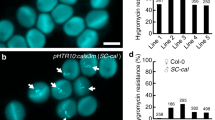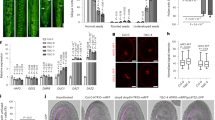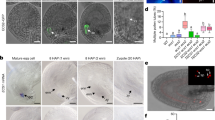Abstract
Sperm cells of seed plants have lost their motility and are transported by the vegetative pollen tube cell for fertilization, but the extent to which they regulate their own transportation is a long-standing debate. Here we show that Arabidopsis lacking two bHLH transcription factors produces pollen without sperm cells. This abnormal pollen mostly behaves like the wild type and demonstrates that sperm cells are dispensable for normal pollen tube development.
This is a preview of subscription content, access via your institution
Access options
Access Nature and 54 other Nature Portfolio journals
Get Nature+, our best-value online-access subscription
$29.99 / 30 days
cancel any time
Subscribe to this journal
Receive 12 digital issues and online access to articles
$119.00 per year
only $9.92 per issue
Buy this article
- Purchase on Springer Link
- Instant access to full article PDF
Prices may be subject to local taxes which are calculated during checkout


Similar content being viewed by others
References
Dresselhaus, T., Sprunck, S. & Wessel, G. M. Curr. Biol. 26, R125–R139 (2016).
McCue, A. D., Cresti, M., Feijo, J. A. & Slotkin, R. K. J. Exp. Bot. 62, 1621–1631 (2011).
Dumas, C., Knox, R. B. & Gaude, T. Protoplasma 124, 168–174 (1985).
Liu, J. et al. Curr. Biol. 23, 993–998 (2013).
Hamamura, Y. et al. Curr. Biol. 21, 497–502 (2011).
Kliwer, I. & Dresselhaus, T. Plant Signal. Behav. 5, 885–889 (2010).
Zhou, X. & Meier, I. Proc. Natl Acad. Sci. USA 111, 11900–11905 (2014).
Lin, Q. et al. Plant Cell 27, 2894–2906 (2015).
Huang, Q., Dresselhaus, T., Gu, H. & Qu, L.-J. J. Integr. Plant Biol. 57, 518–521 (2015).
Preuss, D., Rhee, S. Y. & Davis, R. W. Science 264, 1458–1460 (1994).
Leydon, A. R. et al. Curr. Biol. 23, 1209–1214 (2013).
Schönberger, J., Hammes, U. Z. & Dresselhaus, T. Plant J. 71, 173–181 (2012).
Berger, F. & Twell, D. Annu. Rev. Plant Biol. 62, 461–484 (2011).
Hou, Y. et al. Curr. Biol. 26, 2343–2350 (2016).
Higashiyama, T. & Yang, W. Plant Physiol. 173, 112–121 (2017).
Boisson-Dernier, A. et al. Development 136, 3279–3288 (2009).
Borg, M. et al. Plant Cell 26, 2098–2113 (2014).
Iwakawa, H., Shinmyo, A. & Sekine, M. Plant J. 45, 819–831 (2006).
Yang, C. Y., Vizcay-Barrena, G., Conner, K. & Wilson, Z. Plant Cell 19, 3530–3548 (2007).
Picelli, S. et al. Nat. Methods 10, 1096–1098 (2013).
Trapnell, C. et al. Nat. Protoc. 7, 562–578 (2012).
Acknowledgements
We thank F. Tang and Y. Hu (Peking University, China) for technical help in single-cell RNA extraction, library construction and RNA-seq analysis. We are grateful to T. Aoyama and T. Tsuge (Kyoto University, Japan) for suggestions on preparing the manuscript. This work is supported by National Natural Science Foundation of China (grant Nos. 31620103903, 31621001 and 31370344) and partially by the 111 project. The Qu laboratory is supported by the Peking-Tsinghua Joint Center for Life Sciences and the Dresselhaus lab by the Collaborative Research Center SFB924. The supplementary materials contain additional data.
Author information
Authors and Affiliations
Contributions
L.-J.Q., H.G., J.D. and T.D. designed the study; Q.L. generated single mutants. J.Z. and Q.H. generated double mutants and, together with S.Z. and A.B., performed phenotypic analysis. Q.H. and J.Z. conducted RNA-seq analysis; Q.H. and J.H. performed bioinformatics analysis. X.G. and S.Z. performed the SIV PT attraction assay. L.-J.Q., J.Z., S.Z., H.G., J.D. and T.D. interpreted the data and wrote the manuscript.
Corresponding author
Ethics declarations
Competing interests
The authors declare no competing financial interests.
Supplementary information
Supplementary Information
Supplementary Figures 1-7, Supplementary Tables 1 and 2, Supplementary Methods, Supplementary References. (PDF 1709 kb)
Rights and permissions
About this article
Cite this article
Zhang, J., Huang, Q., Zhong, S. et al. Sperm cells are passive cargo of the pollen tube in plant fertilization. Nature Plants 3, 17079 (2017). https://doi.org/10.1038/nplants.2017.79
Received:
Accepted:
Published:
DOI: https://doi.org/10.1038/nplants.2017.79
This article is cited by
-
Establishment of in vitro pollen germination system in C4 model plant Foxtail Millet
Plant Cell, Tissue and Organ Culture (PCTOC) (2024)
-
Distinct chromatin signatures in the Arabidopsis male gametophyte
Nature Genetics (2023)
-
Projected climate-driven changes in pollen emission season length and magnitude over the continental United States
Nature Communications (2022)
-
Fertilized egg cells secrete endopeptidases to avoid polytubey
Nature (2021)
-
Two types of bHLH transcription factor determine the competence of the pericycle for lateral root initiation
Nature Plants (2021)



